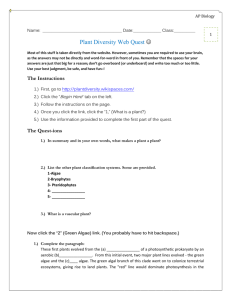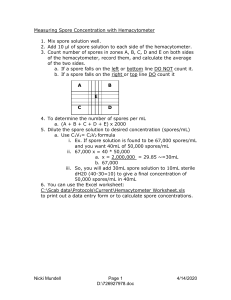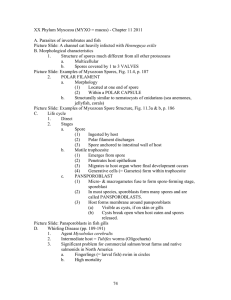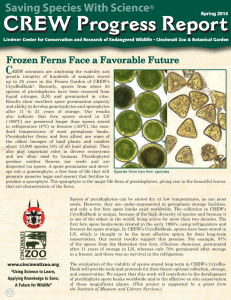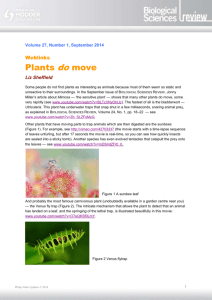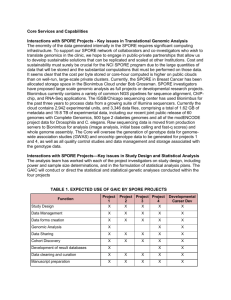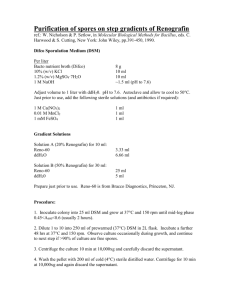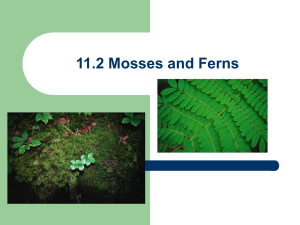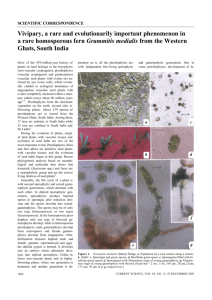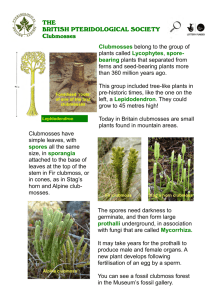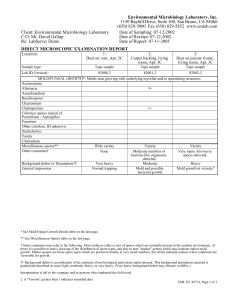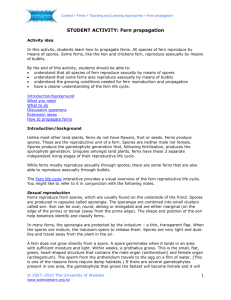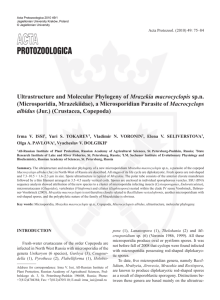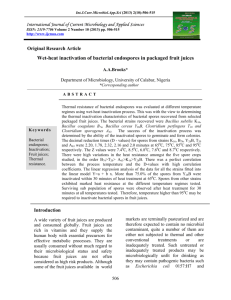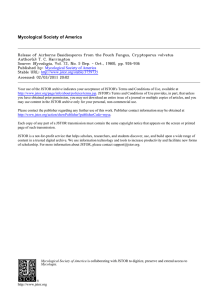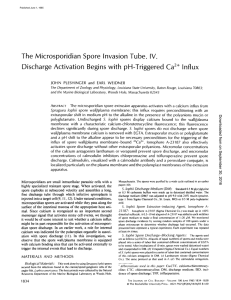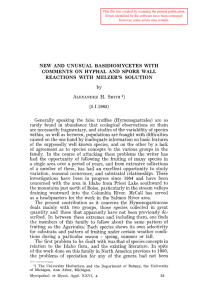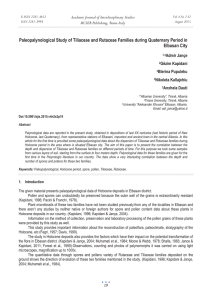Key to Lab manual 11 - Napa Valley College
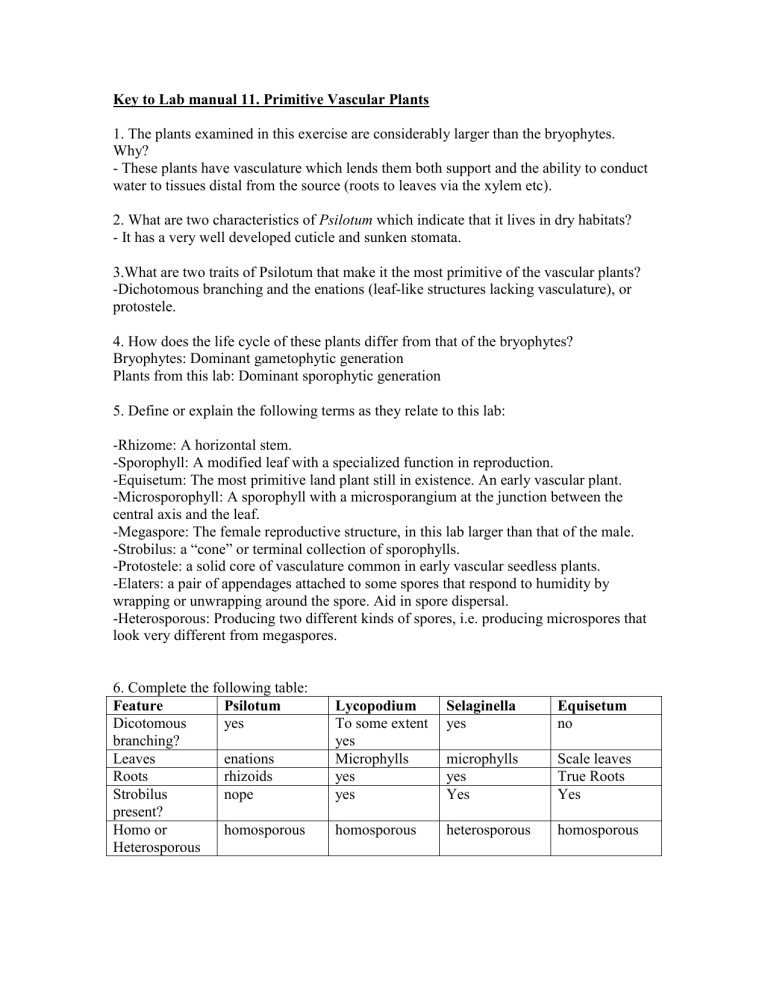
Key to Lab manual 11. Primitive Vascular Plants
1. The plants examined in this exercise are considerably larger than the bryophytes.
Why?
- These plants have vasculature which lends them both support and the ability to conduct water to tissues distal from the source (roots to leaves via the xylem etc).
2. What are two characteristics of Psilotum which indicate that it lives in dry habitats?
- It has a very well developed cuticle and sunken stomata.
3.What are two traits of Psilotum that make it the most primitive of the vascular plants?
-Dichotomous branching and the enations (leaf-like structures lacking vasculature), or protostele.
4. How does the life cycle of these plants differ from that of the bryophytes?
Bryophytes: Dominant gametophytic generation
Plants from this lab: Dominant sporophytic generation
5. Define or explain the following terms as they relate to this lab:
-Rhizome: A horizontal stem.
-Sporophyll: A modified leaf with a specialized function in reproduction.
-Equisetum: The most primitive land plant still in existence. An early vascular plant.
-Microsporophyll: A sporophyll with a microsporangium at the junction between the central axis and the leaf.
-Megaspore: The female reproductive structure, in this lab larger than that of the male.
-Strobilus: a “cone” or terminal collection of sporophylls.
-Protostele: a solid core of vasculature common in early vascular seedless plants.
-Elaters: a pair of appendages attached to some spores that respond to humidity by wrapping or unwrapping around the spore. Aid in spore dispersal.
-Heterosporous: Producing two different kinds of spores, i.e. producing microspores that look very different from megaspores.
6. Complete the following table:
Feature
Dicotomous branching?
Leaves
Roots
Strobilus present?
Psilotum yes enations rhizoids nope
Lycopodium
To some extent yes
Microphylls yes yes
Selaginella yes microphylls yes
Yes
Equisetum no
Scale leaves
True Roots
Yes
Homo or
Heterosporous homosporous homosporous heterosporous homosporous
Key to Lab Manual 12. Ferns
1. How does a fern prothallus differ from a moss protonema in appearance?
- It is greatly reduced by comparison and looks like a small heart. It is also a flattened sheet of cells, rather than the initial filamentous growth of mosses.
2. How does the internal organization of the fern stem (rhizome) differ from that seen in
Psilotum ?
-The vasculature of the fern stem is considerably different than that of the whisk fern.
Whisk ferns have protosteles, real ferns have siphonosteles with leaf gaps.
3. Under what weather conditions are spores most likely to be released from the sporangium? What is the advantage of this?
- Spores are released during dry conditions. Because spores are wind dispersed, it makes sense that they are released when water is not abundant. It would not be beneficial to the parent to generate too many offspring that germinate nearby (competition for resources).
4. Bryophytes, primitive vascular plants, and ferns all demonstrated some of unusual features associated with humidity and spore dispersal. What were these activities?
Marchantia
Mosses
Psilotum
Dry
Good for spore dispersal
Sporangia open when dry
Humid
Good for spore dispersal.
Raindrops allow gemma to move from gemmae cup.
Equisetum
Ferns
Elaters respond to changes in humidy, and therefore increase how much spores can move in response to their environment
Spores are released by catapult mech due to annulus
Sporangium close up.
5. Is the indusium haploid or diploid?
-The indusium is derived from the frond and is therefore diploid.
6. The antheridia and archegonia are located on the underside of the prothallus. Of what benefit is this to the plant?
-The gametangia are closer to the water and won’t dry out as fast. Water is also required for fertilization, the male gametes are motile.
7. The completed diagram from after the young sporophyte goes: mature sporophyte, fiddlehead, sporangium, spore mother cell, meiosis, tetrad of spores, spores, spore dispersal, spore germination, prothallus (after here it branches two ways, either
antheridium or archegonium). The antherdia goes to sperm and sperm transfer while the archegonia goes strait to egg. Then the egg and the sperm come together for fertilization and the genation of a zygote that will develop into an embryo and so on.
